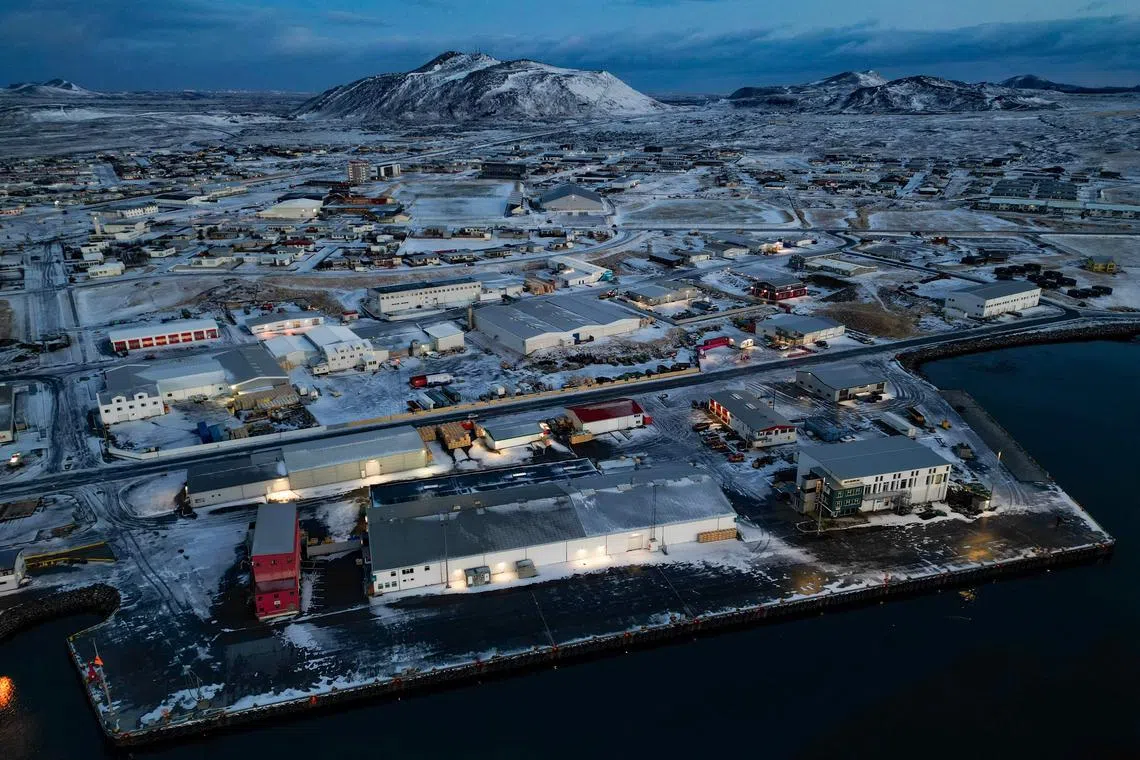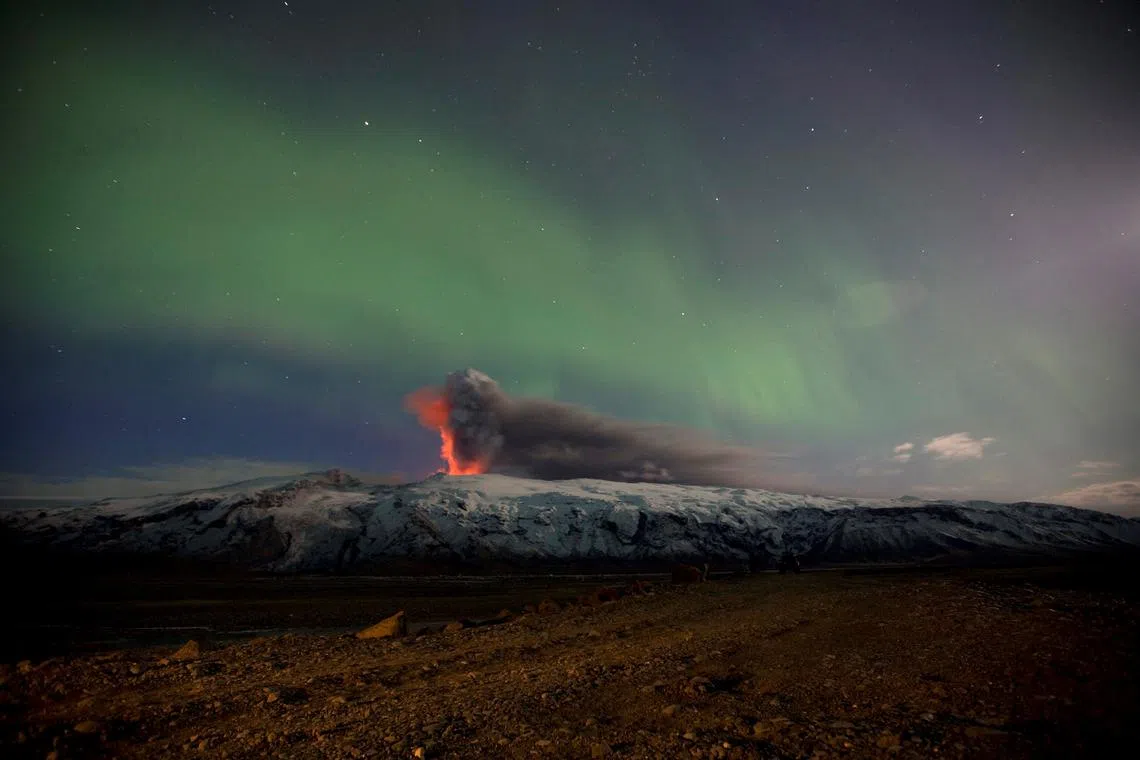Iceland keeps feeding its tourist boom. Will it push locals out?
Sign up now: Get ST's newsletters delivered to your inbox

The port of the evacuated Icelandic town of Grindavik after a volcanic eruption in the south of the capital Reykjavik in December.
PHOTO: AFP
Follow topic:
REYKJAVIK – Downtown Reykjavik is buzzing with life despite the arrival of winter. In the old city centre, tourists in thermal jackets snap photos at every corner and tour buses make their way towards the otherworldly natural sites that attract millions of sightseers each year to this sparsely populated volcanic island.
After a dip during the pandemic, Iceland received an estimated 2.2 million visitors in 2023, and is expected to welcome up to 2.5 million in 2026. New hotels and restaurants dot the capital, knitwear and artisanal crafts makers are doing brisk business, and the streets are noticeably busier than they were a decade ago.
The more tourists arrive, the more workers are needed, and the country’s population grew in 2022 by more than 3 per cent – the fastest uptick on record. Recent seismic activity close to the capital also sparked travel interest, as “volcano tourism” – which, under calmer circumstances, can include treks to active areas – has become increasingly popular.
All this is good news for the economy, which latched onto the sector after the infamous collapse of the country’s banking system in 2008. But it also poses problems for the roughly 400,000 Icelanders, who are struggling with the challenges of living in a country predominately oriented around tourism.
Far from the crowds in downtown Reykjavik, Mr Jon Ferdinand Estherarson, a 31-year-old Icelander, unpacked his things at an apartment that he and his wife finally secured after four stressful months of searching. “We were very anxious, because we didn’t know what we would get and everything we saw was either outrageously expensive or very small and inadequate,” he reflected.
Like many others, the young couple are dependent on a strained rental market, whose offerings are increasingly being repurposed as short-term lets. “It feels like every other place is an Airbnb,” he complained. He and his wife, who both worked in tourism until recently, had been looking for an apartment since their previous landlord informed them that he was moving back from abroad.
After viewing a parade of small, expensive, poorly maintained and mould-infested options, Mr Estherarson finally found a place through friends. The fact that it was in the suburbs also came as a relief. “We feel the peace and quiet now,” he said.
Iceland, a country slightly larger than Ireland, is seeing its supply of long-term housing dwindle. In the capital area, almost 8 per cent of all residential housing is listed on Airbnb, according to a study by AirDNA, and home stay licences have increased 70 per cent in 2023, compared with 2022. According to a 2019 study, at least half of all apartments in some centrally located districts are tourist rentals, and up to two-thirds of homes listed on Airbnb were previously for long-term tenants.
Mr Mar Mixa, an associate professor of finance at the University of Iceland, said converting long-term units into Airbnbs can be enormously profitable. The problem, he said, is that the repurposed rentals “haven’t been taxed accordingly, and there aren’t incentives in place to construct buildings unrelated to tourism”.
To address the problem, the government rolled out its very first housing policy in 2023, pledging to build 4,000 apartments a year for the next five years. But things are not off to a good start: The latest estimates show that closer to 5,000 apartments a year are needed, and only 2,800 were expected to be completed by January. Meanwhile, the end of cheap money has dramatically reduced new-build construction.
Compounding the problem is the fact that Iceland has historically been a home-owning culture. Only about a fifth of Icelanders rented in 2022, according to Statistics Iceland, down from nearly a third before the pandemic. With fewer places available, a 2021 report found that as many as 7,000 people – just under 2 per cent of the total population – had taken up residency in illegal housing, including commercial buildings.
While the squeeze is perhaps most acutely felt by renters, owners have also come under pressure from soaring interest rates, which at a staggering 9.25 per cent are the highest in Western Europe. Some have seen their monthly mortgage payments double in the past year as the central bank has hiked rates to cool the overheated economy.
Central bank governor Asgeir Jonsson put it bluntly at the bank’s last rate meeting in late November: “This is an economy growing too fast.”
Mr Finnbjorn A. Hermannsson, president of the Icelandic Confederation of Labour, offered a more specific diagnosis. “Tourism has been creating inflation, and the general wage earner is paying for it,” he said.
The country’s tourism boom began in 2009, after a dramatic economic meltdown led to US$100 billion (S$133 billion) in banking losses and the collapse of the currency. Suddenly, the once-prohibitively expensive island was affordable to visitors. Government-run marketing campaigns and Icelandic Air deals (free stopover in Reykjavik, anyone?) were rolled out to lure travellers, and glimpses of Iceland’s lava fields and geysers in big-budget films provided extra incentive to visit.
Then, in 2010, the Eyjafjallajokull volcano erupted, releasing a vast plume of ash that grounded air traffic across Europe for weeks – and put Iceland in the centre of the global news cycle. When it cleared up, tourists went back to booking plane tickets.

The Northern Lights above the ash plume of Iceland’s Eyjafjallajokull volcano on April 23, 2010.
PHOTO: REUTERS
Over a decade later, some of the country’s most popular hot spots receive close to 6,000 visitors a day, raising questions about how best to preserve its pristine natural landscapes. Increasingly, developers are moving away from high-traffic areas and into territories such as the Icelandic highlands, the largest stretch of European wilderness that has never been inhabited or cultivated.
The owners of the Blue Lagoon, a geothermal spa that receives around one million visitors a year and has been closed since intense seismic activity last November, are one such example. They recently opened a resort at the base of the Kerlingafjoll mountains in the central highlands, and are planning another in Thjorsardalur, a southern valley near waterfalls and hot springs.
Discussions are also afoot about establishing a national park, so highland protection will not be left to a patchwork of small municipalities and private companies.
To address these issues and others, the government is working on a six-year sustainable tourism plan. In an interview with Bloomberg, Prime Minister Katrin Jakobsdottir said she was also considering imposing tourism fees in the light of how “cumbersome” the problem had become.
“This is, of course, delicate because tourism has been very important as a foreign revenue sector,” she added.
Striking the right balance is the immediate challenge. In spite of the problems associated with it, tourism has helped keep Iceland’s unemployment rate low, contributed to the growth of real wages, and thrown a lifeline to villages that took a hit when the fishing industry consolidated in the 1980s. And thanks to a steady influx of visitors, some remote towns are now able to sustain restaurants and cafes they would not have been able to before.
Mr Jon Bjarki Bentsson, head of Islandsbanki Research, said: “Tourism is the main source of growth in the Icelandic economy, and that comes with pros and cons.”
Moving ahead, one related issue that the government needs to address is diversifying the job market. Of the roughly 200,000 people employed in Iceland, about 35,000 are in tourism.
Economist Arsgeir Brynjar Torfason said: “We have not been very active in making policies for the kind of labour market we want to create.”
Mr Estherarson, the new renter in Reykjavik, has experienced the consequences. Despite holding a master’s degree in history, he has struggled to find work in his field. After a decade as a waiter and shift manager at hotels, he is fed up with hospitality, and does not see other opportunities in Iceland for himself or his wife. So for now, he is weighing his options.
“Our dream,” he said, “is to go abroad.” BLOOMBERG

